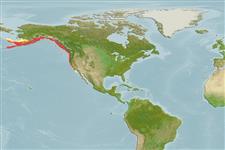Teleostei (teleosts) >
Perciformes/Cottoidei (Sculpins) >
Agonidae (Poachers) > Brachyopsinae
Eponymy: Cygnus G Chesnon (dates unknown) published a rare book on the natural history of Normandy, France (1835), in which he proposed the name Occa (now = Somateria) for a genus of eider ducks. [...] (Ref. 128868), visit book page.
Environment: milieu / climate zone / depth range / distribution range
Ecology
Marine; demersal; depth range 18 - 425 m (Ref. 6793). Temperate
Northeast Pacific: Bristol Bay, Alaska to Unimak Island in the Aleutian chain and Point Montara, California, USA (Ref. 6793); extended to southeastern Bering Sea (Ref. 51659).
Size / Weight / Age
Maturity: Lm ? range ? - ? cm
Max length : 20.0 cm TL male/unsexed; (Ref. 2850)
Dorsal spines (total): 8 - 9; Dorsal soft rays (total): 6 - 9; Anal spines: 0; Anal soft rays: 10 - 12; Vertebrae: 35 - 37. Dorsal fins touching or nearly so; caudal rounded; anal long based and rather low; pectorals broad, lower 4 to 6 rays thickened and not joined by membrane as far as their ends; pelvic fins reduced (in males, long pelvic fins reaching as far as the origin of the anal fin) (Ref. 6885). Dark gray or brown on upper surface, paler beneath, the line of demarcation very clear on head; some individuals with 6 or more dark saddle-shaped markings over back and extending on sides; dorsal fins with dark bands following free margins on fins; longitudinal dark coloring follows rays of caudal fin, especially at distal ends; rows of dark spots on rays of pectorals, and a bright orange spot in its center; dark spots on eyeballs more abundant on upper part (Ref. 6885).
Found on soft bottoms (Ref. 2850).
Life cycle and mating behavior
Maturity | Reproduction | Spawning | Eggs | Fecundity | Larvae
Eschmeyer, W.N., E.S. Herald and H. Hammann, 1983. A field guide to Pacific coast fishes of North America. Boston (MA, USA): Houghton Mifflin Company. xii+336 p. (Ref. 2850)
IUCN Red List Status (Ref. 130435: Version 2024-1)
Threat to humans
Harmless
Human uses
Tools
Special reports
Download XML
Internet sources
Estimates based on models
Preferred temperature (Ref.
123201): 2.9 - 8.6, mean 5.3 °C (based on 283 cells).
Phylogenetic diversity index (Ref.
82804): PD
50 = 1.0000 [Uniqueness, from 0.5 = low to 2.0 = high].
Bayesian length-weight: a=0.00389 (0.00180 - 0.00842), b=3.12 (2.94 - 3.30), in cm total length, based on all LWR estimates for this body shape (Ref.
93245).
Trophic level (Ref.
69278): 3.2 ±0.3 se; based on size and trophs of closest relatives
Resilience (Ref.
120179): Medium, minimum population doubling time 1.4 - 4.4 years (Preliminary K or Fecundity.).
Fishing Vulnerability (Ref.
59153): Low vulnerability (10 of 100).
